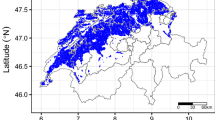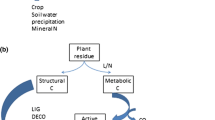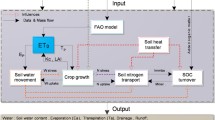Abstract
A field experiment with lettuce was carried out to evaluate the simulation model, N_ABLE, which has been widely used to predict soil mineral nitrogen requirements and potential leaching hazards for vegetable and arable crops in England and parts of Western Europe. Plant and soil were sampled regularly and dry weight (W), percent N in dry matter and soil mineral N (soil-N) were measured. Measured W and soil-N were compared with data simulated using N_ABLE both during growth and at final harvest. Dry weight followed an asymmetrical S-shaped curve when the growth period was either 57 or 61 days for all N levels. This implies that N_ABLE, which assumes a J-shaped growth curve, can only be used in the first three-quarters of the growing period. Simulated soil-N in the 0–30 cm layer corresponded well with measured values throughout the experiment when parameters for the recovery of soil mineral N (REC) and mineralisation rate of soil organic-N (NR) were set at 0.70 (i.e. 70%) and 0.86 kg ha-1 d-1 respectively, both calculated from field data, and were higher than default values. For longer periods of growth, the best fit was obtained using a modified asymmetrical S-shaped growth curve equation dW/dT = k2W Gf Gk /(1+ W), where k is a growth rate coefficient, G (≤ 1) is a correction coefficient to allow for any restriction in growth rate caused by sub-optimal%N in the crop and G= ( W/W)n is another correction coefficient to adjust the growth rate which is decreased caused by genetic or other reasons in the later part of the growth period. The S-shaped equation was examined by a lack of fit test, and the results showed that the residual errors ( SS = ∑( y-x)2, where x =simulated values, y = measured values) were not significantly different from experimental error, indicating that the S-shaped equation gave a good description of growth for the different N levels through the growth periods.
Similar content being viewed by others
References
Addiscott TM & Whitmore AP (1987) Computer simulation of changes in soil mineral nitrogen and crop nitrogen during autumn, winter and spring. J Agric Sci Cam 109: 141–157
Angus JF, Bowden JW & Keating BA (1993) Modelling nutrient responses in the field. Plant and Soil 155/156: 57–66
Barnett V, Landau S, Colls JJ, Craigon J, Mitchell RAC & Payne RW (1997) Predicting wheat yields: the search for valid and precise models. In: J Wiley and Sons (ed.). Precision Agriculture: Spatial and Temporal Variability of Environmental Quality. Chichester, Ciba Foundation Symposium 210: pp 79–99
De Willigen P & Neeteson JJ (1985) Comparison of six simulation models for the nitrogen cycle in the soil. Fert Res 8: 175–171
Evans LT (1975) Crop and world food supply, crop evolution, and the origins of crop physiology. In: Evans LT (ed) Crop Physiology Some Case Histories, pp 1–22
France J & Thornley JHM (1984) Mathematical Model in Agriculture. pp 75–94. Kent: Butterworths & Co Ltd
Graf B, Dingkuhn M, Schnier F, Coronel V & Skita S (1991) A simulation model for the dynamics of rice growth and development: III. Validation of the model with high-yielding varieties. Agric Syst 36: 329–349
Greenwood DJ & Draycott A (1989a) Experimental validation of an N-response model for widely different crops. Fert Res 18: 153–174
Greenwood DJ & Draycott A (1989b) Quantitative relationships for growth and N content of different vegetable crops grown with and without ample fertiliser-N on the same soil. Fert Res 18: 175–188
Greenwood DJ, Cleaver TJ, Loquens SMH & Niendorf KB (1977) Relationship between plant weight and growing period for vegetable crops in the United Kingdom. Ann Bot 41: 987–997
Greenwood DJ, Neeteson JJ & Draycott A (1985) Response of potatoes to N fertiliser: Dynamic model. Plant and Soil 85: 185–203
Greenwood DJ, Neeteson JJ & Draycott A (1986) Quantitative relationships for the dependence of growth rate of arable crops on their nitrogen content, dry weight and aerial environment. Plant and Soil 91: 281–301
Greenwood DJ, Verstraeten LMJ, Draycott A & Sutherland RA (1987) Response of winter wheat to N-fertiliser: Dynamic model. Fert Res 12: 139–156
Greenwood DJ, Kubo K, Burns IG & Draycott A (1989c) Apparent recovery of fertilizer N by vegetable crops. Soil Sci Plant Nutr, 35: 367–381.
Greenwood DJ, Neeteson JJ, Draycott A, Wijnen G & Stone DA (1992) Measurement and simulation of the effects of N-fertiliser on growth, plant composition and distribution of soil mineral-N in nation-wide onion experiments. Fert Res 31: 305–318
Greenwood DJ, Rahn CR & Draycott A (1996a) Modelling nitrogen fertiliser requirements of field grown crops: N-ABLE Nitrogen fertiliser model Handbook (Version Jan 1996) Horticulture Research International, Warwick, UK
Greenwood DJ, Rahn CR, Draycott A, Vaidyanathan LV & Paterson C (1996b) Modelling and measurement of the effects of fertiliser-N and crop residue incorporation on N-dynamics in vegetable cropping. Soil Use and Management 12: 13–24
Groot JJR & Verberne ELJ (1991) Response of wheat to nitrogen fertilisation, a data set to validate simulation models for nitrogen dynamics in crop and soil. Fert Res 27: 349–383
Hunt R (1982) Plant growth curves, the functional approach to plant growth analysis. London: Edvard Arnold
Jackson LE, Stivers LJ, Warden BT and Tanji KK (1994) Crop nitrogen utilisation and soil nitrate loss in a lettuce field. Fert Res 37: 93–105
Jamieson PD, Porter JR, Goudriaan J, Ritchie JT, van Keulen H & Stol W (1998) A comparison of the models AFRCWHEAT2, CERES-Wheat, Sirius, SUCROS2 and SWHEAT with measurements from wheat grown under drought. Field Crop Research 55: 23–44
Jones CA (1990) Use of crop simulation models in dryland agriculture. Advances in Soil Science 13: 333–345
Kabat P, Marshall B, van den Broek BJ, Vos J & van Keulen H (1995) Modelling and parameterization of the soil-plantatmosphere system. A comparison of potato growth models, pp 439–501 Wageningen: Wageningen Pers
Mackerron DKL (1992) Agrometerorological aspects of forecasting yields of potato within the E.C. Joint Research Centre, Commission of E.C.: pp 157–169
MAFF (1983) Chafer grubs. MAFF publication leaflet 235. UK: HMSO
MAFF (1994) Fertiliser recommendations for agricultural and horticultural crops (RB209), pp 64–65. London: HMSO
O'Leary GJ & Connor DJ (1996a) A simulation model of the wheat crop in response to water and nitrogen supply: I. Model construction. Agric Syst 52: 1–29
O'Leary GJ & Connor DJ (1996b) A simulation model of the wheat crop in response to water and nitrogen supply: II. Model validation. Agric Syst 52: 31–55
Riley H & Guttormsen G (1994) N requirements for cabbage crops grown on contrasting soils. II. Model verification and predictions. Norwegian J Agric Sci 8: 99–113
Royston JP (1982) An extension of Shapiro and Wilk's W Test for Normality to large samples. Applied Statistics 2: 115–124
SAS Institute Inc (1990) SAS/ETS Software: Applications Guide 2, Version 6, First edition: Econometric Modelling Simulation and Forecasting. pp 67–98 Cary, NC
Singh U & Thornton PK (1992) Using crop models for sustainability and environmental quality assessment. Outlook on Agriculture 21: 209–218
Sorensen JN, Johansen AS & Poulsen N (1994) Influence of growth conditions on the value of Crisphead lettuce: 1. Marketable and nutritional quality as affected by nitrogen supply, cultivar and plant age. Plant Foods for Human Nutrition 46: 1–11
Soundy P, Smith IE (1992) Response of lettuce (Lactuca sativa L) to nitrogen and phosphorus fertilization. Journal of the Southern African Society for Horticultural Sciences 2: 82–85
Welch SM, Croft BA & Michels MF (1981) Validation of pest management models. Environmental Entomology 10: 425–432
Whitmore AP (1991) A method for assessing the goodness of computer simulation of soil processes. J Soil Sci 42: 289–299
Author information
Authors and Affiliations
Rights and permissions
About this article
Cite this article
Yang, J., Wadsworth, G., Rowell, D.L. et al. Evaluating a crop nitrogen simulation model, N_ABLE, using a field experiment with lettuce. Nutrient Cycling in Agroecosystems 55, 221–230 (1999). https://doi.org/10.1023/A:1009818101373
Issue Date:
DOI: https://doi.org/10.1023/A:1009818101373




